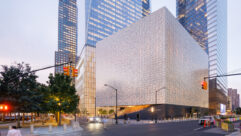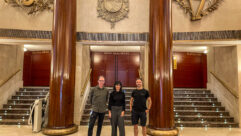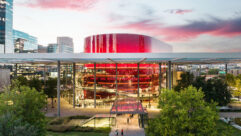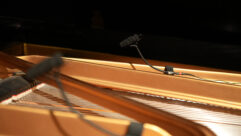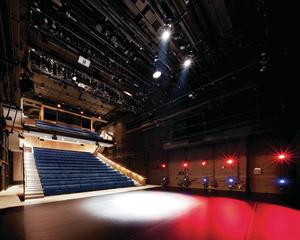

Future-Proofing a Performing Arts Theater
Even if the Jerome Robbins Theater at New York’s Baryshnikov Arts Center never decides to use it, the AV team that overhauled the venue laid the infrastructure to support current and future systems.
CHALLENGE: Build a theater’s AV infrastructure for the future without holding up a gala grand opening.
In the winter of 2010, the baryshnikov arts Center in New York City celebrated the grand opening of its Jerome Robbins Theater. Located on the third and fourth floors of the center (formerly know as the 37 Arts building), the small, proscenium-style theater has been outfitted for a range of artistic programming, from dance and theater to music and multimedia entertainment. It’s also been integrated with AV technology that its designer calls an “infrastructure roadmap” for future performing arts buildings, with a digital audio network and Cat-6 and fiber-optic cabling, as well as all the analog AV systems that a theater might need today.Jim Niesel, senior consultant for engineering and design firm Arup, says his guiding principle on the Robbins Theater project was to specify everything it should have today, while making it forward-compatible with what might come along in the future. Too often clients get blindsided by new technology, he says, which means greater cost down the road when they need to add the latest AV, lighting, and communications.”In a typical theater, we’ve got a lot more trades than we do on other jobs,” Niesel says. “There are rigging guys and other theater-specific trades, in addition to electricians and all the others. Everyone was working in each others’ armpits.”
SOLUTION: Lay down all the cabling required for analog and digital AV networking pre-opening and finish up the AV installation as opportunities allow.
The new Jerome Robbins Theater includes fiber, copper, and Ethernet AV cabling to handle both current and future needs.
Credit: Alexander Severin/RAZUMMEDIA
Now, renovating underutilized theater space (or as Time Out New York described it, a “sad, creepy, asymmetrical, concrete, orange-seated, poorly sightlined” space) on the upper floors of a Manhattan commercial building can be tricky enough. The fact that the theater had to open months before the final AV systems were to be installed meant the technology foundation had to be well thought-out.
Credit: Alexander Severin/RAZUMMEDIA
“By putting all the potential infrastructure that the client might need on fiber, Ethernet, and copper, and bringing it all through to patch panels where it might be needed, we’ve offered the client much greater flexibility,” Niesel explains. “There will always be some onus on the client to upgrade in the future, but this concept will help.”
Challenges are inherent to retrofit AV projects, and the Robbins Theater design was a perfect example, Niesel says. Taking up two floors in the building and with studios above it, the theater space itself was relatively smalljust 75 by 42 feet. There was a flat floor stage at one end of the space and a full complement of battens and drapery. Space was at a premium.
Structurally, the building that houses the Robbins Theater is concrete. Because of this, the AV team was working in an immovable box and everything had to be surface-mounted. The architect, WASA/Studio A, decided to run raceways for trunking through the space to facilitate running lines. All the lines entered stage left, with equipment located stage right. As a result of using of raceways, Niesel says installers faced additional challenges in maintaining adequate cable separation.
The project schedule was aggressive. There were only nine months from demolition to the scheduled grand opening in February. The small jobsite complicated efforts to do multiple things at once.
Credit: Alexander Severin/RAZUMMEDIA
AV integrator AVI-SPL was awarded the contract late in the build-out process. Baryshnikov Arts Center officials didn’t start talks with the integrator until October 2009. “The client was already freaked out about budget and time when they brought on AVI-SPL,” Niesel says. When AVI-SPL explained that it couldn’t finish the AV systems in time due to the unique construction circumstances, Niesel says the news actually soothed the client’s nerves and convinced them that the completed installation would be of extremely high-quality.
To make the AV integration manageable and move the project forward, the general contractor split the contract and brought in another subcontractor to pull cable and terminate panels. That way all the infrastructure was finished and out of sight in time for the gala opening. Installing AV gear in racks and hanging speakers would wait until later.
“The biggest challenge for the poor integrator was that they were in the building during performances, so they had to work around the facility’s schedule,” Niesel explains. The team constantly managed the client’s expectations. The theater appeared to have a fully functioning AV system, but until AVI-SPL finished the installation several months later, it didn’t, really. (AVI-SPL declined to describe its work on the project because it did not have the client’s permission.)
Future-Proofing a Performing Arts Theater
Even if the Jerome Robbins Theater at New York’s Baryshnikov Arts Center never decides to use it, the AV team that overhauled the venue laid the infrastructure to support current and future systems.
Niesel used Arup’s own SoundLab software to model the space and auralize it for the client, design team, and prospective users so they could better understand what the finished theater would sound like and make informed decisions along the way.
NOT OVER THE TOP
EQUIPMENT LIST
Below is a partial list of the equipment specified and installed by Arup and AVI-SPL at the Jerome Robbins Theater in New York’s Baryshnikov Arts Center.
- 2 Audio-Technica AT4021 pencil cardoid condenser mics
- Bosch WZ20 IR/color camera
- Clear-Com MS702 main station
- 5 Clear-Com RS602 two-channel wired beltpacks
- 5 Clear-Com Cellcom 10 two-channel wireless beltpacks
- 10 Clear-Com CC26 and CC95 headsets
- 4 Countryman Associates B3 wireless lavalier microphones
- 2 Denon Professional CD DN635 professional CD players
- Echo Digital Audio AudioFire 8 recording interface
- Extron Electronics SSP 7.1 surround sound processor
- Extron Electronics MAV 8×16 matrix switcher
- Extron Electronics DVS 304 scaler
- Listen Technologies LS82 assistive listening system
- 4 Listen Technologies LR44 lanyard receivers
- 4 Listen Technologies LR42 stethoscope receivers
- 7 Meyer Sound MM4-XP self-powered miniature loudspeakers
- 18 Meyer Sound UPM-1P ultracompact wide-coverage loudspeakers
- 4 Meyer Sound USM-1P stage monitors
- 2 Meyer Sound 600HP subwoofers
- 6 Meyer Sound UPA-1P compact wide-coverage loudspeakers
- 2 NEC MultiSync video monitors
- 4 Shure SM58 wireless handheld microphones
- 2 Shure KSM9 wireless handheld microphones
- 2 Shure SM58 wired microphones
- 2 Shure Beta58 wired microphones
- 4 Shure SM57 wired microphones
- 3 Yamaha DME64 digital signal processors
- Yamaha SB168ES EtherSound stage box
- Yamaha LS9-32 digital audio console with EtherSound card
Source: ARUP
The AV technology in the now-complete Jerome Robbins Theater is that of a hybrid, incorporating not only Cat-6 and fiber, but also analog AV over copper. The fact that the client OK’d such an infrastructure is a testament to the consultant’s ability to explain the plan’s strengths.
Niesel says the theater industry is still on the fence when it comes to digital audio, even though the rest of the pro AV industry is well into its transition from analog to digital. But because the space was intended for use by a variety of arts groups, there was no way to be certain of what equipment they’d bring into the theater with them. The answer, then, was to prepare the space for anything and everything. “Since the theater [has] only 238 seats, some would say that running fiber is over the top,” Niesel says. “We disagree. We want to do it once, and do it right.”
The AV team put in an EtherSound audio network, a Yamaha LS9-32 console, several Yamaha digital signal processors, Meyer Sound speakers, and a Clear-Com intercom system. It used a mix of Shure and Countryman microphones, as well as a Listen Technologies assistive listening system.
The Baryshnikov Arts Centers pervasive concrete architecture presented challenges when laying the AV infrastructure for the new theater.
Credit: Alexander Severin/RAZUMMEDIA
Then there was the matter of the network. All the panels in the Robbins Theater have ports that connect to a computer in the systems rack. The idea was to build a dedicated LAN for all the Robbins Theater users that was independent of the building’s main IT system. “There’s a big push on the IT side to integrate networks and then divvy them up using partition switches,” Niesel explains. But that can lead to technical issues. “There’s an operational issue,” he says. “Who’s responsible for servicing the network if one of those switches fails?”
In the end, no stone was left unturned. The Jerome Robbins Theater might not be the biggest venue in town, but it’s future-proofed against changes in AV technology. And after all the challenges, it’s winning raves in the theater design press.
“The client was willing to work with us and accommodate a difficult schedule,” Niesel says. “That allowed time for the integrator to do a quality installation.”
Lee Distad is a freelance AV writer.


